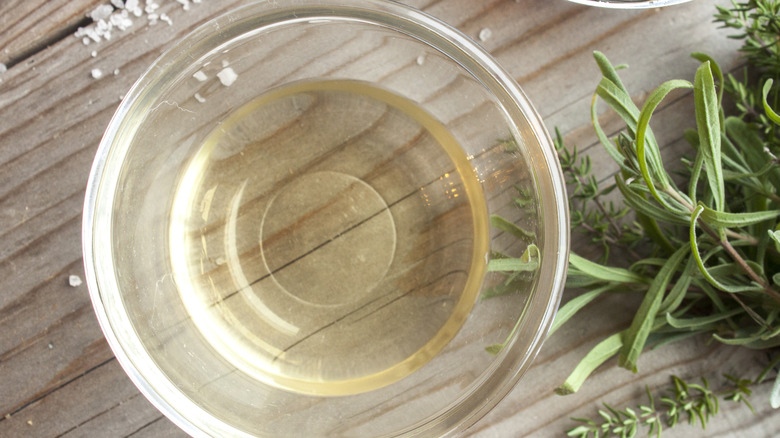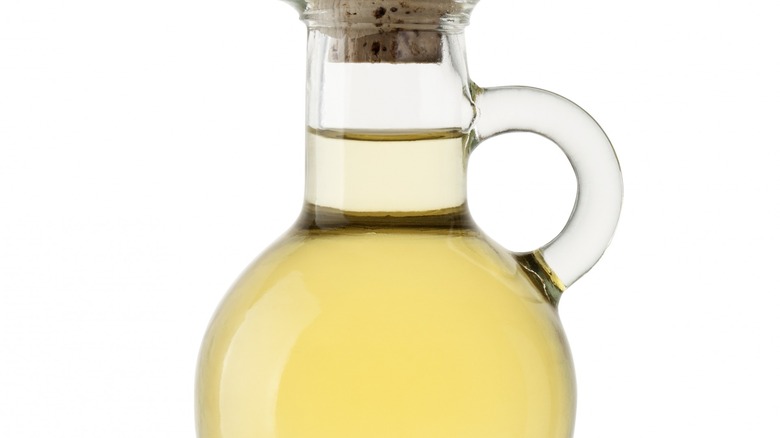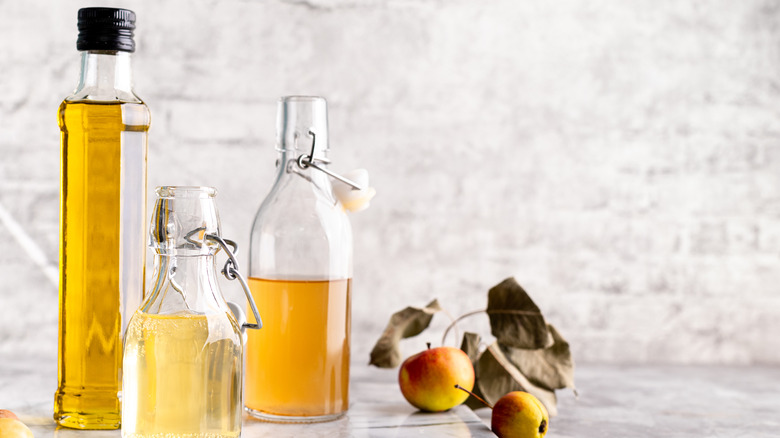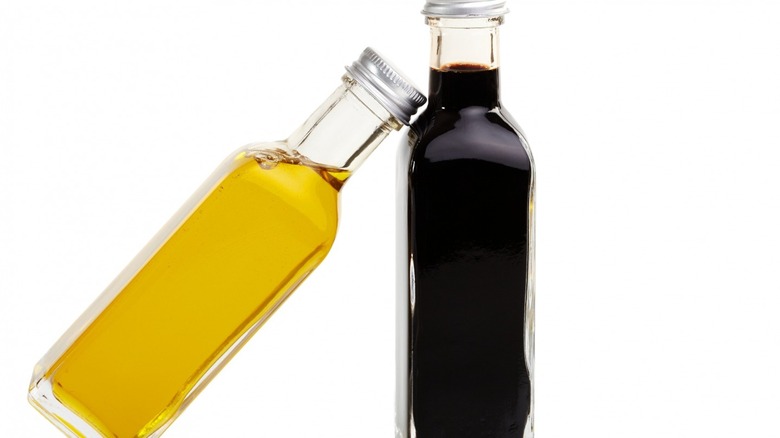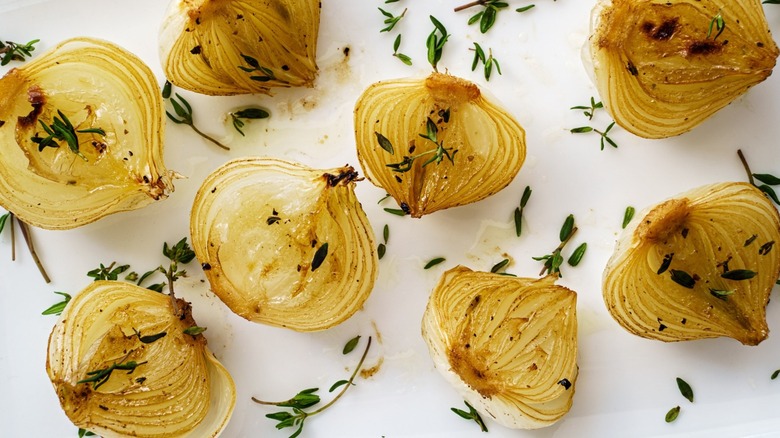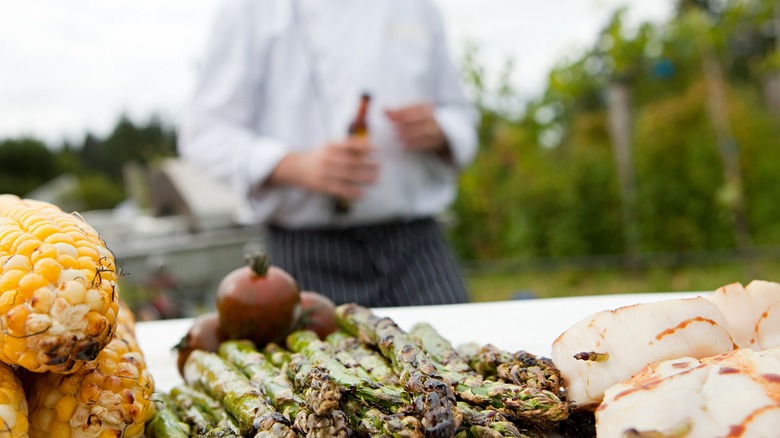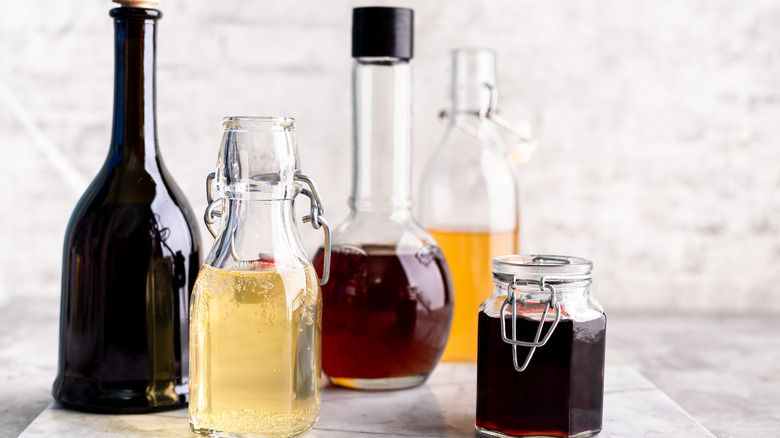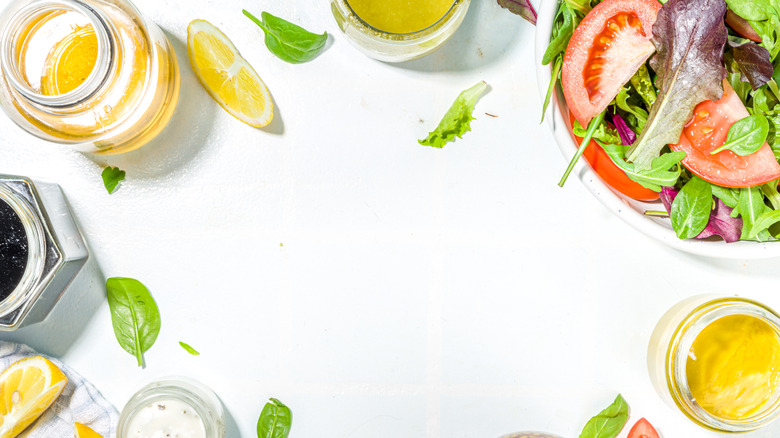White Balsamic Vinegar Is The Chef Staple You Need In Your Kitchen
Chefs often use special ingredients and techniques that make their dishes stand apart from others. One of these ingredients should become a staple in your kitchen as well: white balsamic vinegar. Most people are familiar with the taste and uses of regular balsamic vinegar because it is often used in salads, marinades, and sauces. However, its cousin, white balsamic vinegar, is rarely discussed. This is unfortunate, because this one ingredient has the potential to change the way you cook and present your food.
Chefs often prefer white balsamic vinegar over the traditional variety for its neutral color and its more subtle acidic flavor. In fact, you've probably already tried it, even if you weren't aware. That's because it's often used in restaurants as a substitute for regular balsamic vinegar. White balsamic vinegar can be used interchangeably with traditional balsamic vinegar but has a cleaner finish and doesn't change the color of the dish like regular balsamic vinegar does. If you're craving that vinegar tartness without the added color, this is the one ingredient you need.
What are the ingredients in white balsamic vinegar?
As it turns out, white balsamic vinegar does not actually get its name from the color of grape it's made from. Rather, it derives from the cooking process, which is just as important as the ingredients when making vinegar. White balsamic vinegar typically starts with white sweet grapes from Trebbiano, but it can also be made from the Lambrusco red varieties. Traditionally, the only ingredients are boiled grape must and white wine vinegar.
White balsamic has a light yet tart flavor profile with an acidity range from 5.25% to 7%. The short aging process is what gives white balsamic vinegar its uniquely tangy taste. While some vintners use stainless steel barrels to age the vinegar in order to preserve the flavor, traditional vintners use flavored wooden barrels like oak throughout the process, which gives the vinegar hints of vanilla and a richer flavor.
How is white balsamic vinegar made?
White balsamic vinegar is made similarly to regular balsamic vinegar, but for a shorter period, so that the color doesn't turn brown. The grapes are then pressed into a must. A must is when a vintner presses a whole grape including the seeds, skin, and stem into juice for wine or vinegar and then reduces it. In order to achieve its signature color, the must is then vacuum-cooked with white vinegar at a lower temperature and higher pressure than regular balsamic vinegar. (For regular balsamic vinegar, the must is typically simmered over an open flame in copper kettles until it turns syrupy.)
This cooking process allows white balsamic vinegar to retain a clean appearance with a neutral color. White balsamic vinegar is aged from 1-12 years, which gives it its signature taste and makes it ideal to use on dishes that require tartness but also need a neutral aesthetic. For example, if you used balsamic vinegar on a salad, it would dye the greens. So, chefs use white balsamic vinegar so they can create the same flavor notes but keep the natural look of the salad.
White balsamic vinegar versus traditional balsamic vinegar
Other than the cooking and aging process, there are many differences between these two balsamic vinegars. There is a contrast in their flavor, their color, and the way they are used. Balsamic vinegar is used for its deep color and rich acidic flavor profile and is one of the most commonly used vinegar types for marinades and vinaigrettes. It's also used as a condiment, often over vegetables or fruit.
White balsamic vinegar is used for its lighter flavor and where a neutral color is desired, such as when making light-colored sauces. It's often used in dishes in place of balsamic vinegar in particular because it keeps that familiar acidic profile but doesn't change the dish's color. This vinegar is perfect for making pan sauces because of its lighter flavor — the flavor of regular balsamic vinegar can sometimes overpower a sauce.
One of the greatest attributes of white balsamic vinegar is its ability to brighten up vegetables and fruit without becoming the star of the show. Balsamic vinegar is heavier-handed and preferred for richer dishes. For example, the lighter flavor of white balsamic vinegar pairs nicely with a homemade Greek salad. The slight acidity plays well with the feta cheese, olive oil, and cucumbers. You can also make your own chicken marinade with this vinegar for a main course.
What does white balsamic vinegar taste like?
White balsamic vinegar has a sweet and tangy flavor with a clean aftertaste, which is why it is so popular among chefs. When it is heated up, the moisture evaporates, leaving a more concentrated flavor that adds punch to recipes and can even be reduced to a glaze. This makes it a popular option for deglazing pans, as it adds an acidic flavor to the deglazed bits. There are also slight floral notes which make this a perfect companion to fruit, vegetables, and marinades.
Vinegar, much like wine, takes its flavor profile from its vintage, its age, and the barrel it's aged in more than its ingredients. Different manufacturers have different flavor profiles, even though all white balsamic vinegar is made from two primary ingredients and will generally taste the same. Whether the vinegar is aged in stainless steel or oak barrels also makes a big difference in the overall profile of vinegar. Barrel-aged vinegar will be milder in flavor than those aged in stainless steel, and the wood adds a flavor that stainless steel doesn't.
How to cook with white balsamic vinegar
This vinegar is often used for its flavor profile and clear color to brighten up salads or vegetables or used as a drizzle over fruit, tomatoes, or bread. It is also used to finish soups and sauces, deglazing, and can also be reduced to a concentrated syrup. The tartness balances out sweeter sauces and soups and the concentrated reduction can be used over creamy or dairy-based foods to add zest.
White balsamic vinegar pairs well with tomato-based soups because of its acidity and also works well in marinades — not only as flavoring, but as a meat tenderizer as well. This vinegar can also be brushed on braised meat once it's cooked. It pairs especially nicely with fatty proteins, elevating the richness of the meat and adding pop to the finished dish. It also adds depth to foods centered around umami flavor, like portobello mushrooms.
Where to buy white balsamic vinegar
White balsamic vinegar can be purchased at any local grocery store and online. It's a common condiment that can be found on the same aisle with other vinegars and cooking oils. If you are looking for a particular brand, it might be best to go directly to their website to buy because some specialized brands are not found in everyday markets. Colavita and Alessi are two of the most popular brands and tend to be the easiest to find in most retail outlets.
Shopping for quality vinegar is like shopping for quality wine. You should look for a golden color and a thick viscosity, and the ingredients should only include grape must and white vinegar. A quality balsamic vinegar will have a P.G.I. label on the bottle, which stands for Protected Geographical Indication. This label authenticates the vinegar as having at least one of its stages of production in a designated area — in this case, Modena, Italy.
Nutritional information about white balsamic vinegar
Overall, white balsamic vinegar is a healthy condiment with low calories, low carbohydrates, and very little sugar. Although the nutritional content varies from brand to brand, a 1 tablespoon serving generally contains 20 calories, 4 grams of carbohydrates, and 4 grams of sugar. Balsamic vinegar is packed with antioxidants, which help fight off excessive free radicals in your body, which can contribute to aging, cell damage, infection, and more (via Healthline).
Along with being a low-fat and low-calorie food, there are many health benefits to balsamic vinegar including better digestion, lower cholesterol, and lower blood sugar, per Medical News Today. It is gluten-free because it contains no wheat and it is also keto-friendly. However, it is the least keto-friendly vinegar because of the sugar and carbohydrates. Overall, there are little to no health risks to balsamic vinegar — white or otherwise — and it is a great addition to any diet.
